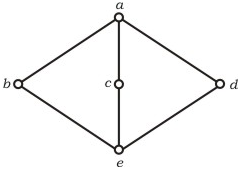GATE-CS-2005
Question 4
Which one of the following are essential features of an object-oriented programming language? (GATE CS 2005) (i) Abstraction and encapsulation (ii) Strictly-typedness (iii) Type-safe property coupled with sub-type rule (iv) Polymorphism in the presence of inheritance
Question 5
A program P reads in 500 integers in the range [0..100] representing the scores of 500 students. It then prints the frequency of each score above 50. What would be the best way for P to store the frequencies?
Question 6
An undirected graph C has n nodes. Its adjacency matrix is given by an n × n square matrix whose (i) diagonal elements are 0\'s, and (ii) non-diagonal elements are l\'s. Which one of the following is TRUE?
Question 7
The time complexity of computing the transitive closure of a binary relation on a set of n elements is known to be
Question 8
Let A, B and C be non-empty sets and let X = (A - B) - C and Y = (A - C) - (B - C). Which one of the following is TRUE?
Question 9
Question 10
Let G be a simple connected planar graph with 13 vertices and 19 edges. Then, the number of faces in the planar embedding of the graph is
There are 90 questions to complete.
